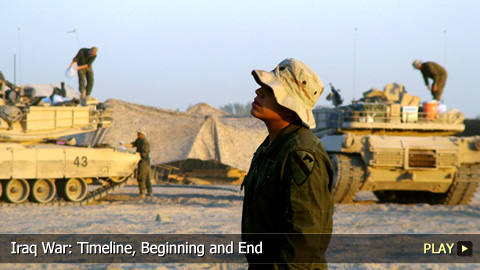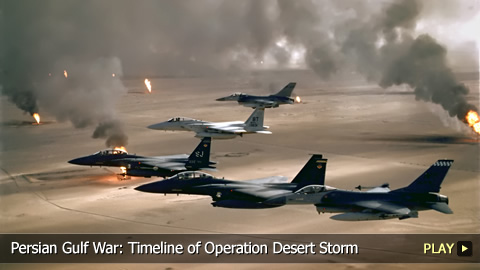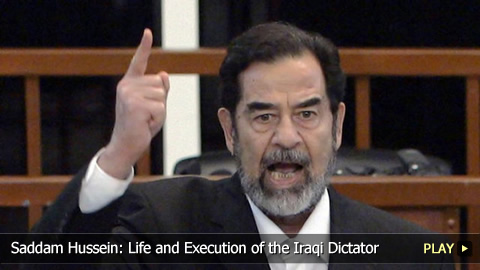Iraq War: Timeline, Beginning and End

Beginning: Gulf War
Persian Gulf War: Timeline of Operation Desert Storm
While the War in Iraq officially began in March 2003, it was decades in the making. After the Gulf War ended in 1991, the United Nations imposed sanctions that prevented Iraq from building or housing weapons of mass destruction. The United States and its allies also pressured Iraq to remove Saddam Hussein as leader.
UN Sanctions
Monsterverse Timeline Explained
Despite these limitations, Iraq was accused of having access to a number of destructive items, including biological weapons, poison gas and more.
Weapons Inspections
Top 10 Most Destructive Weapons Ever Created
Following 9/11, President George W. Bush and his administration attempted disarmament efforts with renewed gusto. Meanwhile, Iraq did not fully cooperate with UN weapons inspections. By 2002, Bush warned that Iraq would face military action should they not allow these security checks.
War on Terror
The COMPLETE God of War Timeline Explained
In October 2002, the Joint Resolution to Authorize the Use of United States Armed Forces Against Iraq was approved by the U.S. Senate, allowing Bush to legally invade Iraq as part of his War on Terror.
Countries Against the Invasion
Top 20 Countries Where Americans Are NOT Welcome
The U.S. also claimed an interest in installing a democratic regime in Iraq. However, fellow NATO members France, Germany and Canada, in addition to Russia, were all against an invasion of Iraq, and instead wanted to disarm the country through diplomatic negotiations.
Operation Iraqi Freedom Begins
Meanwhile, the U.S. and Tony Blair’s United Kingdom pushed ahead with their plans. On March 20th, 2003, Operation Iraqi Freedom began. Almost 250 thousand American soldiers fought beside 45 thousand British soldiers, and more troops from a variety of other nations.
Goals of the Iraq War
Top 20 Unbelievable Messi Goals
With this invasion, the U.S. and UK hoped to end the Hussein regime, eliminate WMDs, remove radical Islamists and give humanitarian aid wherever possible. They also hoped to take control of Iraqi oil, and to install a model democratic government.
Fall of Baghdad
Top 10 Best Taylor Swift Songs to Listen to in the Fall
On April 9th, the U.S.-led coalition took the city of Baghdad, and this signaled the end of Saddam Hussein’s reign. A transitional government was then put into place: the Coalition Provisional Authority stayed in office until mid-2004 and held power over the government of Iraq.
“Mission Accomplished”
Top 20 Mission Impossible Scenes
By May 2003, Bush considered the war a “Mission Accomplished,” and declared victory despite the fact Saddam Hussein had not yet been captured. Insurgent and guerilla attacks increased following that speech and caused a number of U.S. military deaths.
Former Government Leaders Captured
Top 10 Government Leaks
Efforts were then increased to catch former government leaders. Saddam Hussein’s sons were killed, and many important people were captured.
Saddam Hussein Caught
Saddam Hussein: Life and Execution of the Iraqi Dictator
Saddam himself was finally taken at the end of 2003, and this signaled an improvement in conditions as insurgent attacks briefly decreased. Unfortunately, by the spring of 2004, not only did insurgency resume, it also intensified.
Abuse and Abu Ghraib
Top 10 Facts About Prescription Drug Abuse in America
Violent battles like the First and Second Battles of Fallujah resulted in civilian, police and U.S. military deaths. Meanwhile, support at home and abroad waned as it was revealed that the U.S. military was abusing prisoners at Abu Ghraib. In fact, this turned out to be a defining moment of the war.
Iraq Elects Permanent Government
Top 10 Iraq War Movies And TV Shows
Fighting, insurgency, IEDs and suicide bombings continued over the next years. After a general election at the end of 2005, Iraq’s permanent government took control in May 2006. Shortly thereafter, the leader of al-Qaeda in Iraq was located and killed.
Saddam Hussein Executed
At the end of 2006, amid reports that suggested the situation in Iraq was not progressing, Saddam Hussein’s death sentence was carried out after he was found guilty of crimes against humanity.
Surge Strategy
By 2007, the U.S. began employing a surge strategy and deployed more troops. Meanwhile, allies began withdrawing their forces. The next year, things stabilized and fatalities dropped significantly.
U.S. Forces: Out by End of 2011
Red Bull Cliff Diving World Series 2011 - Training to Dive in Malcesine, Italy
2008 also saw the approval of U.S.-Iraq Status of Forces Agreement. Most importantly, this deal meant American troops would be removed from Iraq by the end of 2011. An exit strategy was presented in 2009, and in October 2011 President Barack Obama pledged the American presence would end as promised.
UN Sanctions Lifted
The Complete Walking Dead Timeline Explained
Meanwhile, the restrictions placed on Iraq in the 1990s were lifted by the UN, and this gave the Iraqi government control of the country’s oil.
An Unpopular and Costly War
The "Totally Not Complicated" Mortal Kombat Timeline Explained
Since it began, the Iraq War cost American taxpayers trillions of dollars, and took countless soldier and civilian lives. It ultimately became one of the longest and most divisive battles in U.S. history.


 1
1
 0
0
 report
report















